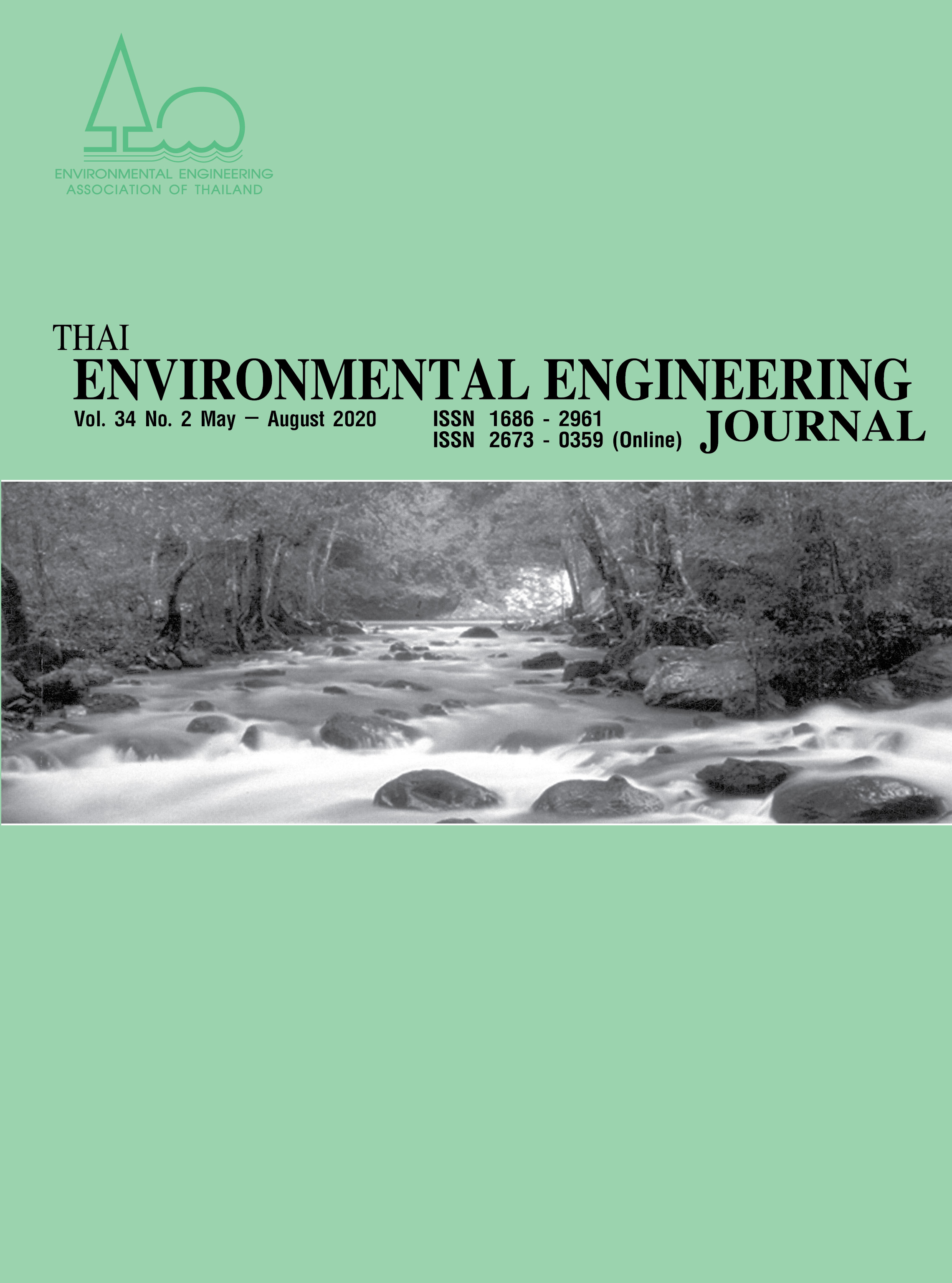Ozonation of Diesel Range Petroleum Hydrocarbon
Main Article Content
Abstract
The use of diesel fuel in waterways transportation often leads to contamination of petroleum hydrocarbon in the environment with adverse effects on water quality and aquatic lives. While bioremediation has limitations in petroleum removal, chemical oxidation is more promising. Ozonation is an effective process for treating organic matters. This study investigated the effect of ozone on diesel range hydrocarbon using synthetic water sample with 100 and 500 mgTPH/L. The experiment was conducted in a batch reactor with ozone supplied from a small scale generator (32.64 mgO3/min). Total Petroleum Hydrocarbon (TPH) removal of 87 and 90% were achieved, in 100 and 500 mgTPH/L respectively, with the removal capability of 0.75 mgTPH/mgO3. After ozonation, aliphatic fraction of diesel range hydrocarbon (C10 – C28) was reduced to some extent. Of all the 6 Polycyclic Aromatic Hydrocarbons (PAHs), present in smaller amount in raw sample, only Naphthalene remained after ozonation. With sufficient ozone dosage, biodegradable portions of TPH were removed. Biodegradability of TPH was very low with BOD removal rate constant (KT) of 0.14 and
0.10 d-1. The values were lowered to 0.07 and 0.04 d-1 after the ozonation treatment.
Article Details
References
American Petroleum Institute. 1994. Interlaboratory Study of Three Methods for Analyzing Petroleum Hydrocarbons in Soils. API Publication No. 4599. American Petroleum Institute, Washington, DC
Hoigne, J. and Bader, H. 1975. Ozonation of water : role of hydroxyl radical as oxidizing intermediates. Science. 190: 782-783.
Hoigné, J. The chemistry of ozone in water. In: Stucki, S. Process Technologies for Water Treatment, 1988. Plenum Publishing Corp., New York.
Hellman, T.M., Hamilton, G.A. 1974. Mechanism of alkane oxidation by ozone in the presence and absence of iron(III) chloride. Journal of the American Chemical Society. 96(5): 1530-1535.
Bailey, P.S. 1982. Ozonation in Organic Chemistry V2: Nonolefinic Compounds. Elsevier.
Zeng, Y., Hong, P.K.A. and Wavrek, D.A. 2000. Integrated Chemical-Biological Treatment of Benzo[a]pyrene. Environmental Science & Technology. 34(5): 854-862.
Zouboulis, A., Samaras, P., Ntampou, X. and Petala M. 2007. Potential ozone applications for water/wastewater treatment. Separation Science and Technology. 42(7): 1433-1446.
Wang, J, Zhang, X., and Li, G. 2013. Compositional changes of hydrocarbons of residual oil in contaminated soil during ozonation. Ozone: Science & Engineering. 35(5): 366-374.
Chen, T., Delgado, A.G., Yavuz, B.M. et al. 2016. Ozone enhances biodegradability of heavy hydrocarbons in soil. Journal of Environmental Engineering and Science. 11(1): 7-17.
Zhu, M., Wang, H., Su, H., You, X. and Jin, W. 2010. Study on oxidation effect of ozone on petroleum-based pollutants in water. Modern Applied Science. 4(1): 6-11.
Rakness , K., Gordon, G., Langlais, B. et al. 1996. Guideline for measurement of ozone concentration in the process gas from an ozone generator. Ozone Science and Engineering. 18: 209-229.
APHA, AWWA and WEF. 2012. Standard Methods for Examination of Water and Wastewater. American Public Health Association. Washington, D.C.
U.S. Environmental Protection Agency. 1993. Provisional guidance for quantitative risk assessment of polycyclic aromatic hydrocarbons. EPA 600-R-93-089.
Thomas, H.A. 1937. The ‘slope’ method of evaluating the constants of the first-stage biochemical oxygen demand curve. Sewage Works Journal. 9(3): 425-430.
Snoeyink, V.L. and Jenkins, D. Biochemical Oxygen Demand. In: Snoeyink, V.L. and Jenkins, D. Water Chemistry. 1980. Wiley
De Souza, C.V. and Correa, SM. 2016. Polycyclic aromatic hydrocarbons in diesel emission, diesel fuel and lubricant oil. Fuel. 185: 925-931.
Lim, M.C.H., Ayoko, G.A., Morawska, L., Ristovski, Z.D. and Jayaratne, E.R. 2005. Effect of fuel composition and engine operating conditions on polycyclic aromatic hydrocarbon emissions from a fleet of heavy-duty diesel buses. Atmospheric Environment. 39: 7836-7848.
Marr, C.L., Kirchstetter, T.W., Harley, R.A., Miguel, A.H., Hering, S.V. and Hammond, S.K. 1999. Characterization of polycyclic aromatic hydrocarbons in motor vehicle fuels and exhaust emissions. Environmental Science and Technology. 33: 3091-3099.


